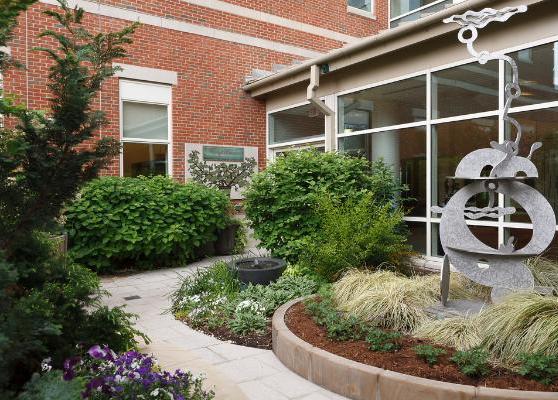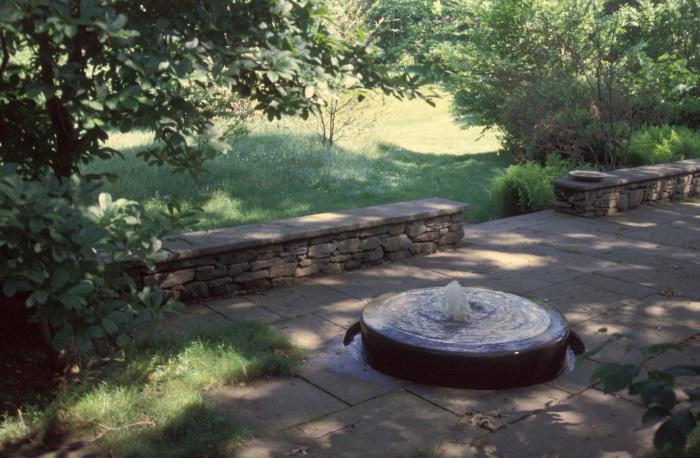Design a Healing Garden
By Jenni Hopkins, Fairfax Master Gardener
“Nature is doing her best each moment to make us well. Why, nature is but another name for health.” Henry David Thoreau

Native and Indigenous healing garden at San Diego State University
Since the beginning of time, healing landscapes have been an important ingredient for human life. As we began to build dwellings and structures, people could go to sacred groves, special rock areas and caves to find healing places within nature. Our Western world had monastic communities that supported infirmaries, which were based on using herbs, prayer and usually a cloistered garden.
Fast forward to our current time and you will see a resurgence of the healing effects of nature. It is no surprise that people who are recuperating from surgery, living in a nursing home, battling depression or attending school with a healing garden area are found to use less medication, heal faster and exhibit less negative emotions. Research tells us that when we connect with nature, positive changes occur in the body: lower blood pressure, decreased heart rate, reduced stress and improvement in our mood.
If healing gardens are to be effective they will need to offer the following elements: sense of control, social support allowing socializing by the users, physical movement and exercise areas and access to nature and other positive distractions.
Healing gardens, also known as therapeutic gardens, provide safe and comfortable settings for people. These gardens universally stimulate the full range of the senses including memory, hearing, touch, smell and also taste. There are two types of healing gardens: restorative and enabling. The restorative garden gives you benefits from walking or sitting and observing the garden and the enabling garden’s therapeutic results occur when you actively garden. Establish the goals that you want for your garden to help design and create which type of healing garden you would desire. Some have both garden designs incorporated in their healing garden because their goals blend the active gardening aspect with the need for stress reduction.

Healing garden at VCU Massey Cancer Center
For touch, you will want to supply plants with contrasting textures including soft and fuzzy to rough and spikey. Good examples would be the smooth bark of a crape myrtle (Lagerstroemia indica), Artemisia varieties that are soft and fuzzy and the Southern magnolia (Magnolia grandiflora) with its leaves being slick and leathery on top and fuzzy and soft underneath. You will want sturdy plants that can withstand the frequent handling.
To create a good sound experience, you should consider grasses rustling or palm fronds swaying in a breeze. Leaves on the ground would give you a nice crunching sound as you walk on them. Coupling these sounds with squirrels chattering and birds singing their songs adds depth to the sound experience. Fountains, wind chimes and waterfalls pique the experience.
Smell is one of the strongest of the human senses, and fragrance will help add another dimension to the garden. Planting Gardenia flowers, the resinous smell of pine needles and even edible plants such as herbs and citrus can contribute strong scents. Even night blooming plants such as night blooming jasmine (Cestrum nocturnum), moonflower vine (Ipomoea alba) and angel’s trumpet (Brugmansia) would be a good consideration. Stepping on an aromatic groundcover such as creeping thyme gives you not only a lovely fragrance but it adds texture.

Children’s Therapeutic Garden, Wellesley, Massachusetts
Lastly, the sense of taste is also an important factor for the healing garden. Anything to be planted needs to be non-toxic. Grow edible flowers such as violets (Viola species), bee balm flowers (Monarda didyma) with their citrus minty flavor, borage (Borago officinalis) which has its crisp cucumber flavor and chives harvested as they are first beginning to open when their flavor is the most pronounced. Also consider planting strawberries and blueberries . Even adding plants for making teas are lovely. Try growing and infusing anise (Pimpinella anisum), hyssop (Hyssopus officinalis}, catmint (Nepata cataria), chamomile (Matricaria recutita) and lemon balm (Melissa officinalis).
As you are planning your healing garden, think about safety and accessibility. This would entail creating wide paths for easy access to all including those using wheelchairs or walkers, using raised beds, vertical plantings and positioning benches and chairs throughout the garden. The hardscape is very important when starting your healing garden. Think of the garden as an outdoor room. The path surfaces need to be firm and smooth and consider privacy walls and shade structures. It is always helpful to incorporate natural elements such as driftwood and large stones. Use of stepping stones is another way to create a pathway. They will make you slow down, helping to take in all that the garden has to offer.
The benefits of having a healing garden small or large, private or commercial are obvious. Interacting with nature puts the mind more in touch with the community and helps to improve the human perceptions of emotional, psychological and social benefits. Plants are considered a symbol of life and they definitely influence all who are around them for good.
If you care to visit some of the healing gardens in our area, here are a few that are recommended:
- Anne Arundel Medical Center Healing Garden located in Annapolis, MD
- Bunny Mellon Healing Garden at Children’s National Hospital in Washington, DC
- Baltimore/Washington Medical Center Healing Gardens in Annapolis, MD
- Virginia Hospital Center Healing Gardens in Falls Church, VA
- Providence Hospital in Washington, DC
References
• Creating a Healing Garden, Pamela Hubbard, Master Gardener, Monroe County, Penn State Extension
• Creating a Sensory Garden, Pamela Hubbard, Master Gardener, Monroe County, Penn State Extension
• Healing Gardens, Betsy Severtsen, Department of Landscape Architecture, University of Washington,
Seattle
• Therapeutic Garden Characteristics, Teresia Hazen, American Horticultural Therapy Association
• Gardening Can Influence and Benefit Your Mental Health, Abby Read, Agrilife Today, Texas A & M
University
• How to Create a Healing Garden at Home, Wendell Combest, Shenandoah University News,
Shenandoah University
• Therapeutic Garden Tips for Home Gardeners, Lesley Fleming, Nova Scotia Horticulture for Health
Network, for National Garden Bureau
• Sensory Gardens, Gardening Solutions, Institute of Food and Agricultural Sciences, University of Florida